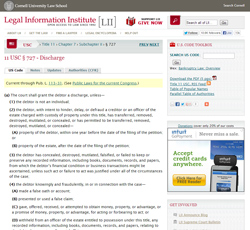Series: #13 0f 13
The previous article in this Overview of Bankruptcy series discussed how stripping off wholly unsecured mortgages is a valuable option in a Chapter 13 case, giving a debtor the opportunity to modify a wholly undersecured second or other junior mortgage. In this last article of the series, we will take a brief look at discharging property settlements during a divorce.
Discharging Property Settlements to Spouse, Ex-Spouse, or Children
Pursuant to 11 U.S.C. § 523*(a)(15), a Chapter 7 filing will not discharge any debt to a spouse, former spouse, or child of the debtor (and not child support) that is incurred by the debtor in the course of a divorce or separation or in connection with a separation agreement, divorce decree or other order of a court of record.
Certainly an argument can be made that a divorce decree that orders the debtor to pay debts of the marriage or attorney fees incurred in a divorce (which are not in the nature of alimony, maintenance or child support) may not be dischargeable in a Chapter 7 filing. The filing, completion and discharge of a Chapter 13 allow the discharge of such debts and protect the debtor from an angry ex-spouse and/or state court judge.
Oftentimes, the ex-spouse has already filed his or her own Chapter 7 in which case, the debtor may be able to file a Chapter 7. A careful review of the divorce decree and the ex-spouses filing (to determine what debts have been listed and discharged) should be taken before making any determination as to the appropriate chapter.
__________
As we mentioned at the beginning of this series, there are many reasons in which a debtor may find as much or more “stress-relief” in a Chapter 13 reorganization. The attorney must be careful to analyze all the benefits and risks (as required by 11 U.S.C. § 526(a)(3)(B) and rules of professional responsibility) before making such a determination as to which chapter is appropriate. If a Chapter 13 is appropriate, then the attorney needs to carefully determine whether such a plan is feasible and offered in good faith to the court. If all of these factors are met, confirmation of the plan is likely to follow.
* Source: Cornell University Law School Legal Information Institute
